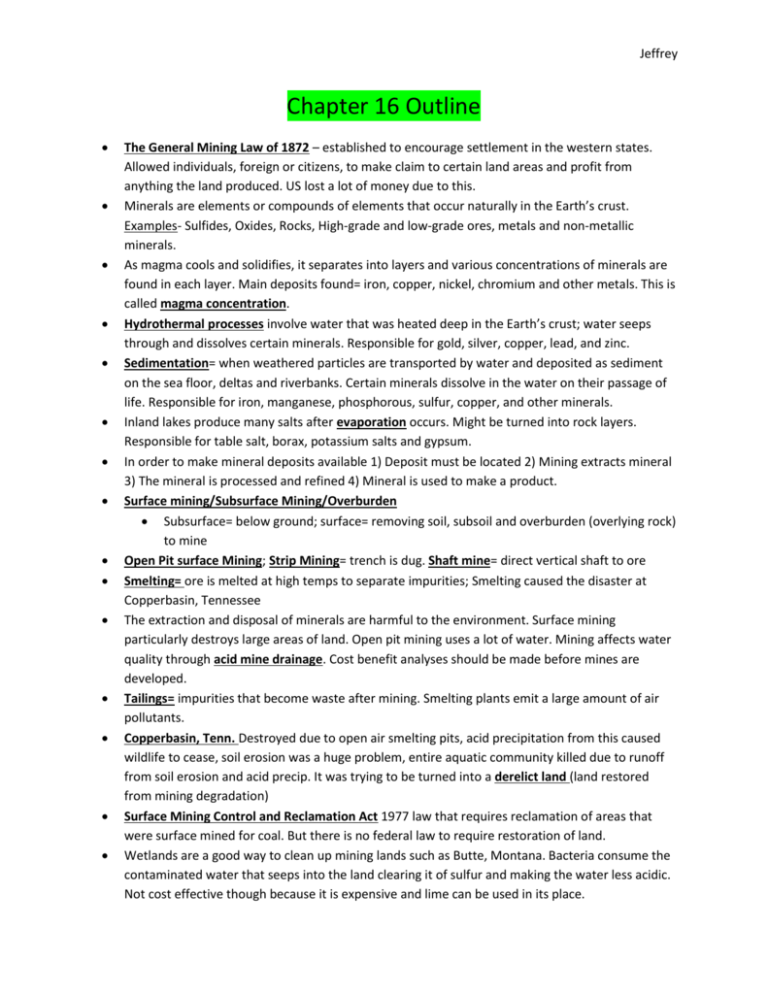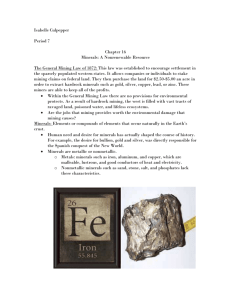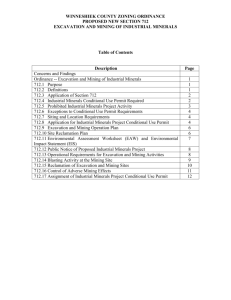Chapter 16 Outline Jeffrey
advertisement

Jeffrey Chapter 16 Outline The General Mining Law of 1872 – established to encourage settlement in the western states. Allowed individuals, foreign or citizens, to make claim to certain land areas and profit from anything the land produced. US lost a lot of money due to this. Minerals are elements or compounds of elements that occur naturally in the Earth’s crust. Examples- Sulfides, Oxides, Rocks, High-grade and low-grade ores, metals and non-metallic minerals. As magma cools and solidifies, it separates into layers and various concentrations of minerals are found in each layer. Main deposits found= iron, copper, nickel, chromium and other metals. This is called magma concentration. Hydrothermal processes involve water that was heated deep in the Earth’s crust; water seeps through and dissolves certain minerals. Responsible for gold, silver, copper, lead, and zinc. Sedimentation= when weathered particles are transported by water and deposited as sediment on the sea floor, deltas and riverbanks. Certain minerals dissolve in the water on their passage of life. Responsible for iron, manganese, phosphorous, sulfur, copper, and other minerals. Inland lakes produce many salts after evaporation occurs. Might be turned into rock layers. Responsible for table salt, borax, potassium salts and gypsum. In order to make mineral deposits available 1) Deposit must be located 2) Mining extracts mineral 3) The mineral is processed and refined 4) Mineral is used to make a product. Surface mining/Subsurface Mining/Overburden Subsurface= below ground; surface= removing soil, subsoil and overburden (overlying rock) to mine Open Pit surface Mining; Strip Mining= trench is dug. Shaft mine= direct vertical shaft to ore Smelting= ore is melted at high temps to separate impurities; Smelting caused the disaster at Copperbasin, Tennessee The extraction and disposal of minerals are harmful to the environment. Surface mining particularly destroys large areas of land. Open pit mining uses a lot of water. Mining affects water quality through acid mine drainage. Cost benefit analyses should be made before mines are developed. Tailings= impurities that become waste after mining. Smelting plants emit a large amount of air pollutants. Copperbasin, Tenn. Destroyed due to open air smelting pits, acid precipitation from this caused wildlife to cease, soil erosion was a huge problem, entire aquatic community killed due to runoff from soil erosion and acid precip. It was trying to be turned into a derelict land (land restored from mining degradation) Surface Mining Control and Reclamation Act 1977 law that requires reclamation of areas that were surface mined for coal. But there is no federal law to require restoration of land. Wetlands are a good way to clean up mining lands such as Butte, Montana. Bacteria consume the contaminated water that seeps into the land clearing it of sulfur and making the water less acidic. Not cost effective though because it is expensive and lime can be used in its place. Jeffrey Phytoremediation= the use of specific plants to absorb and accumulate toxins from the soil. Hyperaccumulators are an example. Mineral Reserves= deposits identified and profitable to extract. Mineral Resources- undiscovered deposits that are currently unprofitable to extract Reserves+Resources= Total Resources or World Reserve Base Reasons shortages of minerals never occurred 1. New discoveries have been discovered 2. Plastics and other synthesizers have replaced metals 3. Global economic slump resulted in lower consumption of minerals Antarctic Treaty- 1961 stated that Antarctica can only be used for peaceful studies. Madrid Protocol- 1990 moratorium on exploration for minerals at a minimum of 50 years. Manganese Nodules – small rocks that contain manganese and other minerals at the bottom of the sea floor. Not commercially feasible to obtain them. UNCLOS- protects the ocean from being exploited. Biomining- microorganisms used to extract minerals from low grade ores. Allows recovery of certain minerals that could be scattered throughout the ocean blue. Reuse/Recycling Sustainable Manufacturing- manufacturing system based on industrial waste minimization. Requires that companies provide info on their waste products. Industrial economies/Industrial ecology- I. Ecology= extension of s. manufacturing because it seeks to use resources efficiently and uses wastes as potential products. I. Ecology -> I. Ecosystem. Dematerialization- a way of conservation/reduction because as time goes on they are made lighter. Compare an iPod in 2003 to an iPod in 2011. MUCH lighter.










